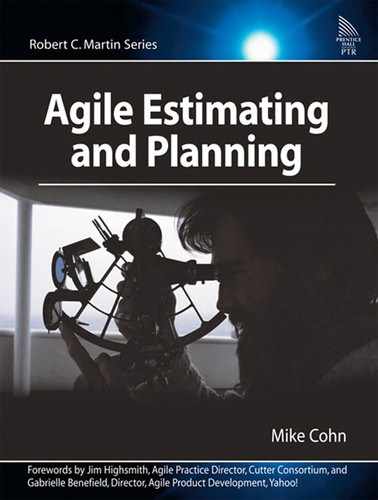Introduction
This book could have been called Estimating and Planning Agile Projects. Instead, it’s called Agile Estimating and Planning. The difference may appear subtle, but it’s not. The title makes it clear that the estimating and planning processes must themselves be agile. Without agile estimating and planning, we cannot have agile projects.
The book is mostly about planning, which I view as answering the question of “What should we build and by when?” However, to answer questions about planning we must also address questions of estimating (“How big is this?”) and scheduling (“When will this be done?” and “How much can I have by then?”).
This book is organized in seven parts and twenty-three chapters. Each chapter ends with a summary of key points and with a set of discussion questions. Because estimating and planning are meant to be whole-team activities, one of the ways I hope this book will be read is by teams who meet perhaps weekly to discuss what they’ve read and the questions at the end of each chapter. Because agile software development is popular worldwide, I have tried to avoid writing an overly United States–centric book. To that end, I have used the universal currency symbol, writing amounts such as ¤500 instead of perhaps $500 or €500 and so on.
Part I describes why planning is important, the problems we often encounter, and the goals of an agile approach. Chapter 1 begins the book by describing the purpose of planning, what makes a good plan, and what makes planning agile. The most important reasons why traditional approaches to estimating and planning lead to unsatisfactory results are described in Chapter 2. Finally, Chapter 3 begins with a brief recap of what agility means and then describes the high-level approach to agile estimating and planning taken by the rest of this book.
The second part introduces a main tenet of estimating, that estimates of size and duration should be kept separate. Chapters 4 and 5 introduce story points and ideal days, two units appropriate for estimating the size of the features to be developed. Chapter 6 describes techniques for estimating in story points and ideal days, and includes a description of planning poker. Chapter 7 describes when and how to re-estimate, and Chapter 8 offers advice on choosing between story points and ideal days.
Part III, “Planning for Value,” offers advice on how a project team can make sure they are building the best possible product. Chapter 9 describes the mix of factors that need to be considered when prioritizing features. Chapter 10 presents an approach for modeling the financial return from a feature or feature set and how to compare financial returns so that the team works on the most valuable items first. Chapter 11 includes advice on how to assess and then prioritize the desirability of features to a product’s users. Chapter 12 concludes this part with advice on how to split large features into smaller, more manageable ones.
In Part IV, we shift our attention and focus on questions around scheduling a project. Chapter 13 begins by looking at the steps involved in scheduling a relatively simple, single-team project. Next, Chapter 14 looks at how to plan an iteration. Chapters 15 and 16 look at how to select an appropriate iteration length for the project and how to estimate a team’s initial rate of progress. Chapter 17 looks in detail at how to schedule a project with either a high amount of uncertainty or a greater implication to being wrong about the schedule. This part concludes with Chapter 18, which describes the additional steps necessary in estimating and planning a project being worked on by multiple teams.
Once a plan has been established, it must be communicated to the rest of the organization and the team’s progress against it monitored. These are the topics of the three chapters of Part V. Chapter 19 looks specifically at monitoring the release plan, while Chapter 20 looks at monitoring the iteration plan. The final chapter in this part, Chapter 21, deals specifically with communicating about the plan and progress toward it.
Chapter 22 is the lone chapter in Part VI. This chapter argues the case for why agile estimating and planning work and stands as a counterpart to Chapter 2, which describes why traditional approaches fail so often.
Part VII, the final part, includes only one chapter. Chapter 23 is an extended case study that reasserts the main points of this book but does so in a fictional setting.
